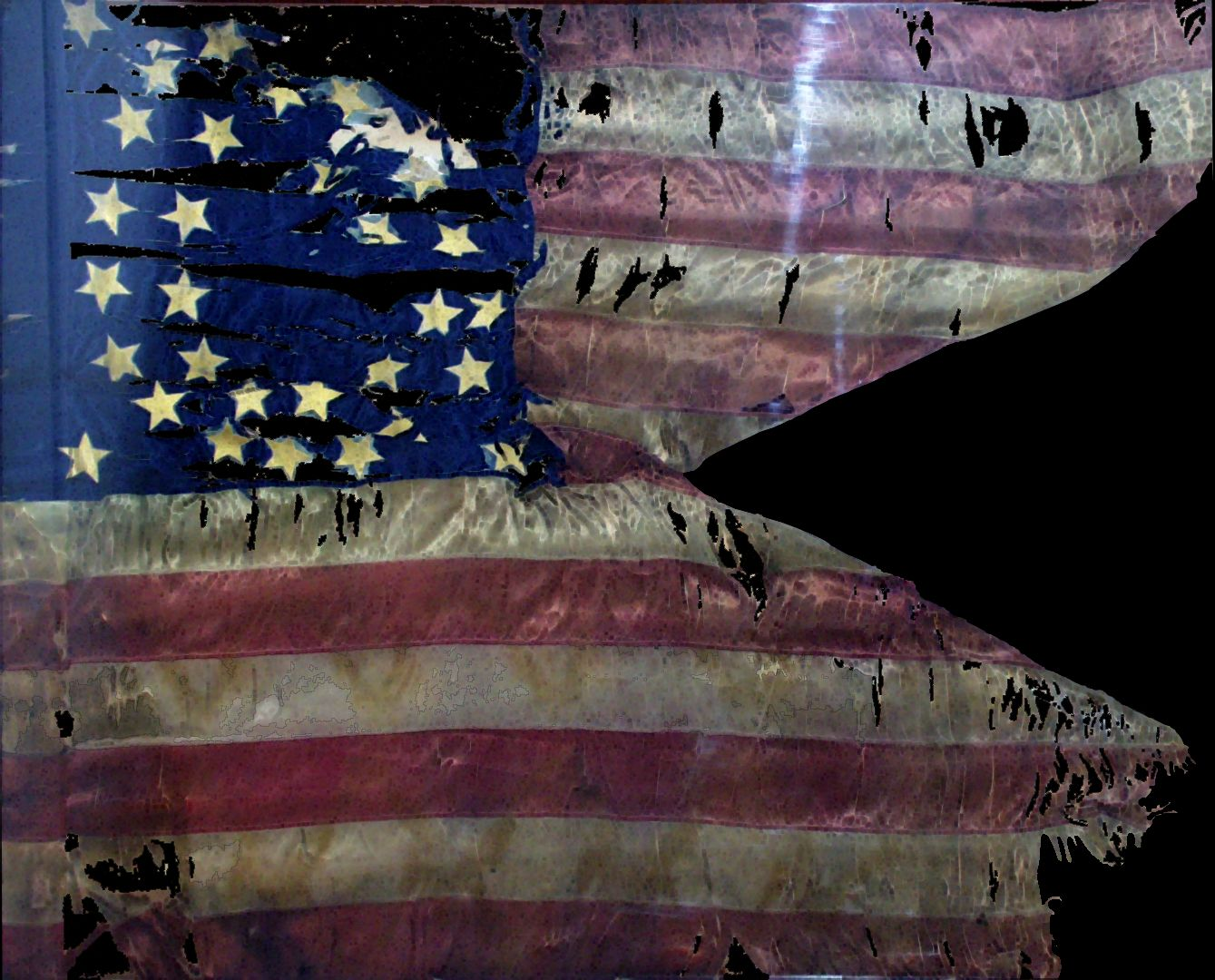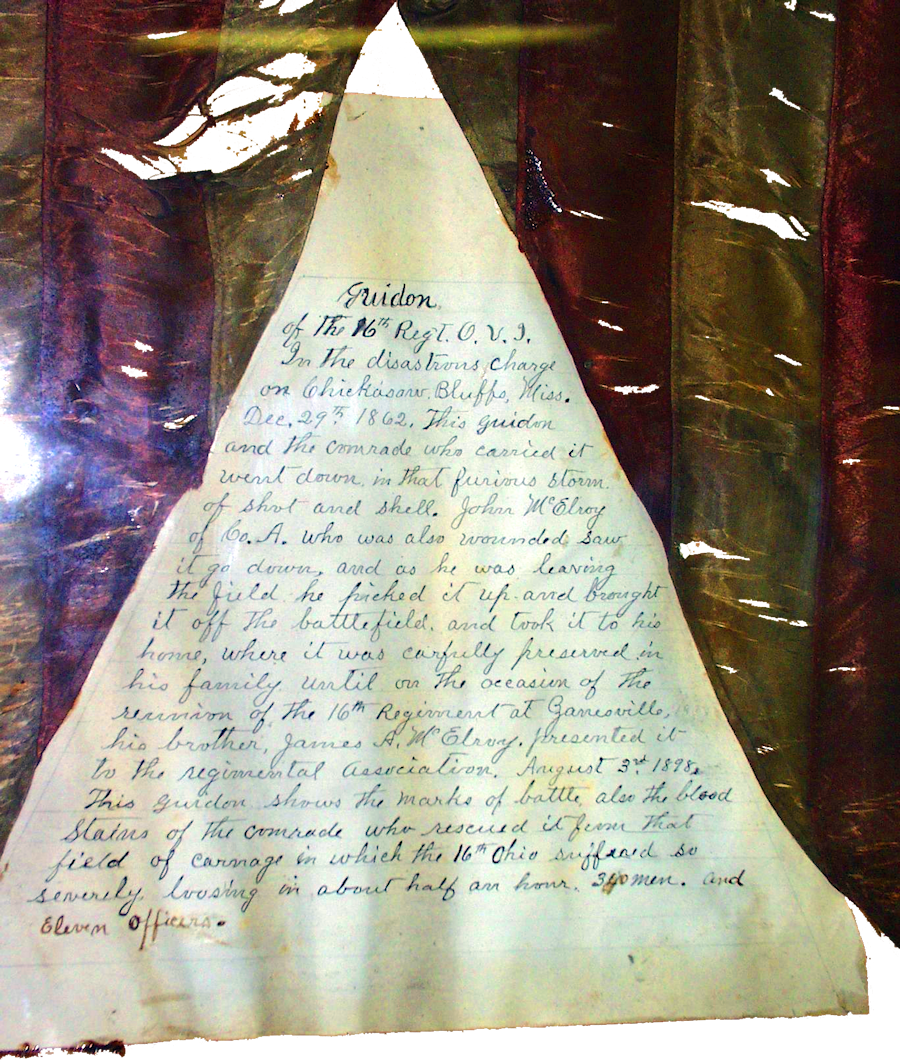| Artifact Index Page | 16th OVI Home Page | Next Artifact |
Artifacts
Guidon from Battle of Chickasaw Bayou
Below is an image of a guidon banner carried by a 16th Ohio soldier at the devastating Battle of Chickasaw Bayou on December 29, 1862. A guidon is used to mark the ends of a specific company's lines on a battlefield. This rare relic has a colorful and poignant history and is considered the most precious surviving relic of the 16th Ohio Volunteer Infantry.
Story of the 16th Ohio Battle Guidon
As the Union soldiers who attacked the bluffs below Vicksburg, Mississippi, on December 29, 1862, found the endeavor to be impossible, being engulfed on nearly all sides by a hail of Confederate cannon and rifle fire with horrendous casualties being inflicted on them, they were forced to retreat back across Chickasaw Bayou. The 16th Ohio was the prominent regiment in this fight and suffered the worst. Twenty year old Private John McElroy, Company A, was wounded and being carried away by members of the hospital corps when he saw a fellow 16th Ohio soldier, an unnamed Sergeant, who was carrying this guidon, fall after being shot. Pvt. McElroy broke away from the medics, retrieved the battle torn and bloodied banner from his dead comrade and placed it inside his coat. He saved it and on a trip home to Ohio gave it to his brother, James A. McElroy, for safekeeping.
The guidon was kept in McElroy's family until the occasion of the regimental 23rd reunion on August 3, 1898, held in Zanesville, Ohio, when brother James presented it to the 16th Ohio Reunion Association, returning it back to the regiment. McElroy's presentation of the guidon is mentioned in the minutes of this reunion. A few years later, believed to have been around 1904 or shortly after, some veterans of the 16th Ohio gave the guidon to the newly formed Wayne County Historical Society in Wooster, where it has resided since.
The guidon was cherished by the historical society and those who fought or had ancestors and friends that fought in the Civil War with the 16th Ohio. In 2002 the historical society, noting the guidon was deteriorating rapidly, decided to have it professionally restored and preserved. A flag preservation specialist was engaged and the banner was successfully restored for just under $8,000. The funds were donated by the Wayne County National Bank, Wayne County Board of Commissioners, Daughters of the American Revolution, descendants of the regiment and the Rainbow Team of Edgewood Middle School in Wooster. The technician who managed the project was Cathy Heffner with Textile Preservation Associates who spent 84 hours on the project. The process included encapsulating the flag in "stabilitex", a polyester fabric dyed to match the deteriorated and missing areas of the original fabric.
Along with the framed guidon were two hand-written letters detailing the history of the relic. One was displayed in the original frame between the swallow tails
and is shown in the second image, below. The second is believed to pre-date the other and was discovered behind the flag during the restoration process. This letter is not currently available but in any case, they both provide ample evidence of the guidon's authenticity and rich history.
The first two images, below, were taken by long-time 16th Ohio website researcher and contributor, H. Arlan Heiser, in the year 2000, before the restoration work. This allows us to see the way the guidon looked before the restoration notwithstanding any deterioration occurring after the war. The guidon was encased in a glass-covered frame causing some glare on the image. Photoshopping techniques were used to remove the brown paper backing visible through the many tears.
The third image, also provided by Mr. Heiser, is of the restored and protected guidon. Thanks, again, to Arlan Heiser who recently worked with Roger Rowe, Charles Leopold and the Wayne County Historical Society to set up a rare photo shoot of the restored guidon. This website offers deep thanks to Arlan, Roger, Charles and the Society for their willingness and passion to get this precious relic of American history photographed and now available for all to see.
The 16th Ohio lost over 300 men and eleven officers at the Battle of Chickasaw Bayou, including the capture of its commander, Lt. Col. Philip Kershner. The name of the sergeant who fell while carrying the flag is not known but it is said that he died on the battlefield, lest Pvt. McElroy would have worked to save the soldier instead of the flag. The guidon flew over the battleground and was seen by many that fateful day. It is highly likely some of the rips and holes you see were caused by Confederate miniballs and cannon shrapnel. It contains bloodstains from Pvt. McElroy and possibly from other soldiers who suffered so terribly that cold, rainy day in December, 1862.
Original 16th Ohio Volunteer Infantry swallow-tail guidon from the Battle of Chickasaw Bayou before restoration.
(photo by Arlan Heiser, ca. 2000)

View of letter telling the history of the guidon and mounted in the original frame.
(photo by Arlan Heiser, ca. 2000)

"Guidon
of the 16th Regt. O. V. I. In the disastrous charge on Chickasaw Bluffs, Miss. Dec. 29th 1862, this guidon and the comrade who carried it went down in that furious storm of shot and shell. John McElroy of Co. A. who was also wounded saw it go down and as he was leaving the field he picked it up and brought it off the battlefield and took it to his home, where it was carefully preserved in his family until on the occasion of the reunion of the 16th Regiment at Zanesville his brother, James A. McElroy, presented it to the regimental association, August 3, 1898. This guidon shows the marks of battle also the blood stains of the comrade who rescued it from that field of carnage in which the 16th Ohio suffered so severely loosing in about half an hour 340 men and eleven officers."
The guidon, after professional restoration, was painstakingly affixed to a special material died to match the original colors of the flag. The material was also shaped to match the original form of the guidon. This process will greatly reduce deterioration, secure the guidon and preserve it for many years to come. (photo by Arlan Heiser, 9/27/2016)

| Artifact Index Page | 16th OVI Home Page | Next Artifact |